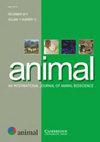Short communication: Do veterinary diagnoses coming from electronic recording system of veterinary treatments have the potential to be used for breeding in small populations? The case of the dual-purpose Alpine Grey cattle breed
IF 4
2区 农林科学
Q1 AGRICULTURE, DAIRY & ANIMAL SCIENCE
引用次数: 0
Abstract
In cattle breeding, emphasis has historically been placed on productive traits, so-called primary traits, while health and fitness traits have been overlooked due to their low heritability and partly negative genetic correlations with productivity. In addition, the recording of phenotypes caused problems due to a lack of high-quality information and / or high costs of recording. This oversight has additionally led to increased incidences of fertility issues and health problems in cattle populations, resulting in economic losses and consumer concerns regarding animal welfare and food safety. This study investigates the potential use of veterinary diagnoses, collected via the Italian electronic recording system of veterinary treatments, for breeding decisions in the local dual-purpose Alpine Grey cattle breed for which the consideration of functional traits in breeding has also become imperative over the last years. The dataset comprised 97 821 records spanning from 2021 to 2023, representing 8 273 individuals and 18 110 lactations of the Alpine Grey breed. Each record documented the administration of treatments for mammary, respiratory, and urogenital pathologies. After data editing and model development, heritability estimates were obtained for each pathology using univariate linear animal models and gibbs sampling algorithms. Results indicate that mammary pathologies affected the highest number of cows (11%), followed by respiratory (4%) and urogenital (5%) pathologies. Heritability estimates ranged from 0.01 to 0.04 across all traits, confirming generally low heritability values. Respiratory pathologies exhibited the highest heritability (0.04; sd 0.04), followed by mammary (0.03; sd 0.01) and urogenital (0.01; sd 0.01) pathologies. This study, although preliminary, provides valuable insights into the health status of local dual-purpose Alpine Grey cattle and highlights the potential of considering veterinary diagnoses for improving animal health and welfare in dairy cattle breeding. However, the low heritability of these traits, which is consistent with literature data, clearly shows the current limitations of using them for breeding. Further, the diagnostic key of the Italian electronic recording system of veterinary treatments should be specified for the use of health data for breeding purposes, as it is formulated in too general manner in its current form. Nevertheless, their significance for animal welfare and economic sustainability underlines the need for their consideration in dairy cattle breeding. Therefore, further research with larger sample sizes and consideration of additional indicators, such as somatic cell counts, is recommended to enhance the accuracy of genetic evaluations and improve breeding strategies for sustainable cattle production.
简短交流:来自兽医治疗电子记录系统的兽医诊断是否有可能用于小种群的育种?高山灰牛两用品种的案例
在牛的育种过程中,生产性状(即所谓的主要性状)历来是育种的重点,而健康和体能性状则因其遗传率低以及与生产率存在部分负遗传相关性而被忽视。此外,由于缺乏高质量的信息和/或记录成本过高,表型记录也造成了问题。这种疏忽还导致牛群中繁殖力问题和健康问题的发生率上升,造成经济损失,并引起消费者对动物福利和食品安全的担忧。本研究调查了通过意大利兽医治疗电子记录系统收集的兽医诊断结果在当地两用高山灰牛品种育种决策中的潜在用途。数据集包括从 2021 年到 2023 年的 97 821 条记录,代表了 8 273 头阿尔卑斯灰牛和 18 110 个泌乳期。每条记录都记录了对乳腺、呼吸道和泌尿生殖系统病症的治疗情况。经过数据编辑和模型开发,利用单变量线性动物模型和吉布斯抽样算法获得了每种病症的遗传率估计值。结果表明,乳腺病变影响的奶牛数量最多(11%),其次是呼吸系统病变(4%)和泌尿生殖系统病变(5%)。所有性状的遗传率估计值从 0.01 到 0.04 不等,证实遗传率值普遍较低。呼吸系统病变的遗传率最高(0.04;sd 0.04),其次是乳腺(0.03;sd 0.01)和泌尿生殖系统(0.01;sd 0.01)病变。这项研究虽然是初步的,但为了解当地两用高山灰牛的健康状况提供了宝贵的信息,并强调了在奶牛育种中考虑兽医诊断以改善动物健康和福利的潜力。然而,这些性状的遗传率较低,与文献数据一致,这清楚地表明了目前将这些性状用于育种的局限性。此外,意大利兽医治疗电子记录系统的诊断关键点应明确用于育种目的的健康数据,因为其目前的形式过于笼统。尽管如此,健康数据对动物福利和经济可持续性的重要意义还是凸显了在奶牛育种中考虑健康数据的必要性。因此,建议进一步开展样本量更大的研究,并考虑体细胞数等其他指标,以提高遗传评估的准确性,改进育种策略,实现可持续的牛生产。
本文章由计算机程序翻译,如有差异,请以英文原文为准。
求助全文
约1分钟内获得全文
求助全文
来源期刊

Animal
农林科学-奶制品与动物科学
CiteScore
7.50
自引率
2.80%
发文量
246
审稿时长
3 months
期刊介绍:
Editorial board
animal attracts the best research in animal biology and animal systems from across the spectrum of the agricultural, biomedical, and environmental sciences. It is the central element in an exciting collaboration between the British Society of Animal Science (BSAS), Institut National de la Recherche Agronomique (INRA) and the European Federation of Animal Science (EAAP) and represents a merging of three scientific journals: Animal Science; Animal Research; Reproduction, Nutrition, Development. animal publishes original cutting-edge research, ''hot'' topics and horizon-scanning reviews on animal-related aspects of the life sciences at the molecular, cellular, organ, whole animal and production system levels. The main subject areas include: breeding and genetics; nutrition; physiology and functional biology of systems; behaviour, health and welfare; farming systems, environmental impact and climate change; product quality, human health and well-being. Animal models and papers dealing with the integration of research between these topics and their impact on the environment and people are particularly welcome.
 求助内容:
求助内容: 应助结果提醒方式:
应助结果提醒方式:


